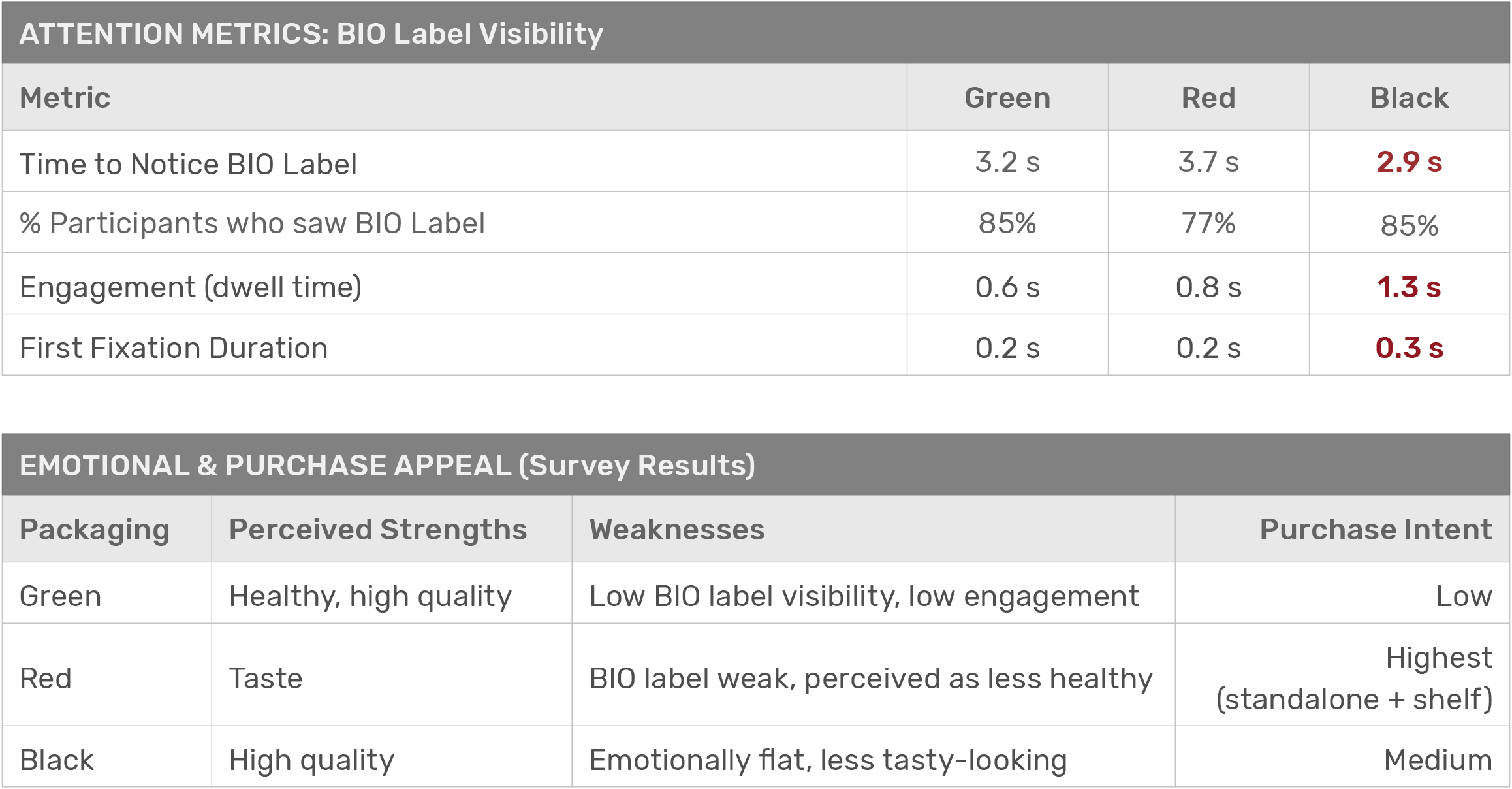29.10.2025
Why Packaging Design Needs Eye Tracking: Data-Driven Insights for Better Consumer Engagement
 by Mirta Ivanek, Product Manager
by Mirta Ivanek, Product Manager
When launching a new product, there’s one critical factor that can make or break consumer engagement – packaging design. Before a customer ever tastes the product, they form an impression based on what they see.
While many marketers rely on assumptions or traditional design rules, the most successful brands today turn to objective, data-driven insights. That’s where eye tracking comes in.
This case study illustrates how visual attention and emotional response interact to shape consumer choices. We walk you through a sample study EyeLogic conducted to evaluate packaging design using eye tracking and consumer perception analysis. The findings reveal not only which design captures attention, but also why visibility doesn’t always align with emotional appeal or purchase intent.
The Challenge: Picking the Right BIO Packaging
An imaginary company, Tasty Treats, is preparing to launch a BIO (organic) chocolate bar. The product itself is ready – but the marketing team is torn between three different packaging designs: green, red, and black.

Their key question:
Which packaging color attracts the most attention and best communicates quality and health?
The Solution: Measuring Consumer Attention with Eye Tracking
Using EyeLogic’s eye tracking technology, the study measured how quickly and how long participants looked at key visual elements – particularly the BIO label.
After viewing each design, participants completed a short consumer perception survey to evaluate emotional appeal and purchase intent for each packaging design.
This combination of objective attention metrics and subjective feedback provides a complete picture of how design influences consumer behavior.
METHODOLOGY OVERVIEW
Participants: 13 individuals aged 15-45, 54% female, 46% male
Location: Germany
Stimuli: 3 packaging variants displayed in both standalone and competitive shelf format
Technology: EyeLogic Lite eye tracker (120Hz) and InsightLab software
Data Collection Flow: Eye tracking session with randomized exposure to 3 packaging options in standalone and competitive shelf context followed by package appeal and purchase intent surveys
Results: What the Eye Tracking Data Revealed

Interpretation: Lower time-to-notice values indicate faster detection; higher dwell time suggests stronger engagement.
Interpretation of Findings
The black packaging drew attention to the BIO label the fastest and held it the longest, showing strong visual contrast and deeper cognitive processing. However, it lacked emotional appeal.
In contrast, the red packaging triggered the highest purchase intent, likely due to taste associations, despite weaker visibility of the BIO label.
The green packaging, though conceptually aligned with “organic”, underperformed because of poor label contrast, reducing visibility and engagement.
Key Insights from the Study
1. Not all attention is equal
Eye tracking showed that visibility alone doesn’t guarantee consumer preference. The black packaging made the BIO label easy to spot, but that didn’t make it the most desirable.
Average time elapsed before first noticing bio label

2. What people see vs. what they feel
The emotional appeal of the red design drove stronger purchase intent even though the BIO label went largely unnoticed. Consumers buy what resonated emotionally – not necessarily what they see first.
3. Design implications
Each color revealed unique trade-offs:
GREEN: Fits the organic concept but suffers from low visual contrast.
RED: Emotionally engaging but weak in highlighting health or sustainability cues.
BLACK: Visually strong for quality signals but lacks warmth or taste appeal.
Strategic Takeaways for Packaging Designers and Marketers
Design For Contrast: Ensure that key elements like “BIO” or “organic” labels stand out clearly against the background.
Validate Color Symbolism: Don’t rely solely on assumptions like “green=healthy”. Always confirm through data.
Iterate With Eye Tracking: Use EyeLogic tools such as Lite and InsightLab to test and refine packaging before going to market.
Eye Tracking = Smarter Packaging Design Decisions
This study highlights how eye tracking for packaging design uncovers subtle but critical differences in how consumers perceive and interact with your product.
By combining objective attention data with subjective perception insights, brands can understand what truly captures attention, identify emotional drivers of purchase, and make evidence-based design decisions.
Whether you are launching a new product or rebranding an existing one, eye tracking helps you see your packaging through your customer’s eyes – literally.
Interested in evaluating your own packaging or marketing assets? Get in touch with us to learn more about how EyeLogic can support your research and design processes.
